The Simple Guide To Seven Common Types Of Trusses
Steel trusses are essential to modern construction - they provide strength and stability for buildings of all types and sizes.
There is a phenomenal amount of science behind steel truss engineering, and it is fascinating to learn about.
In this article, Buffalo River Truss will break down some of the most common types of trusses. We’ll go over each type, examining its uses and common applications.
Let’s get started!
Table of Contents
7 Common Truss Types Explained
Trusses are EVERYWHERE! They are in bridges, towers, big buildings, small buildings, cranes, and more. In fact, they are almost everywhere you look. As an example, think of the Eiffel Tower. The Eiffel Tower is likely the most famous truss structure in the world.
In simple terms, a truss is a structure consisting of a series of interconnected triangular shapes. The triangle is a strong, stable shape, and when you connect materials such as steel in triangular forms, you get a solid framework capable of supporting heavy loads over long spans.
Most trusses are made of triangular forms–and if you vary the way the triangles are interconnected, you can make different types of trusses suited for various purposes. And it’s absolutely crucial to use the right types of truss at the right time–structural difficulties in a bridge or building are the last thing anyone wants!
Let’s look at seven types of steel trusses you may run into.
We’ll start with the simplest, the King Post truss, then move on to the more complex types.
King Post Truss
What is a King Post truss?
The King Post Truss is the simplest form of the truss. It consists simply of one triangle with a vertical dividing it in half and two diagonals like this:

- What are King Post trusses used for? This type of truss is ideal for simple projects like small homes or outbuildings. It is not ideal for long spans or large projects because of its simplicity.
Advantages
- Simple to fabricate and install
- Versatile
- Cost-effective
Disadvantages
- Limited span capacity
- Limited design options
- Limited aesthetic appeal (some find more intricate trusses more appealing for bridges and other structures)
- Doesn’t allow for good headroom or attic space
Queen Post Truss
What is a Queen Post truss?
The second simplest type of truss, the Queen Post appears as a large triangle enclosing a small box:
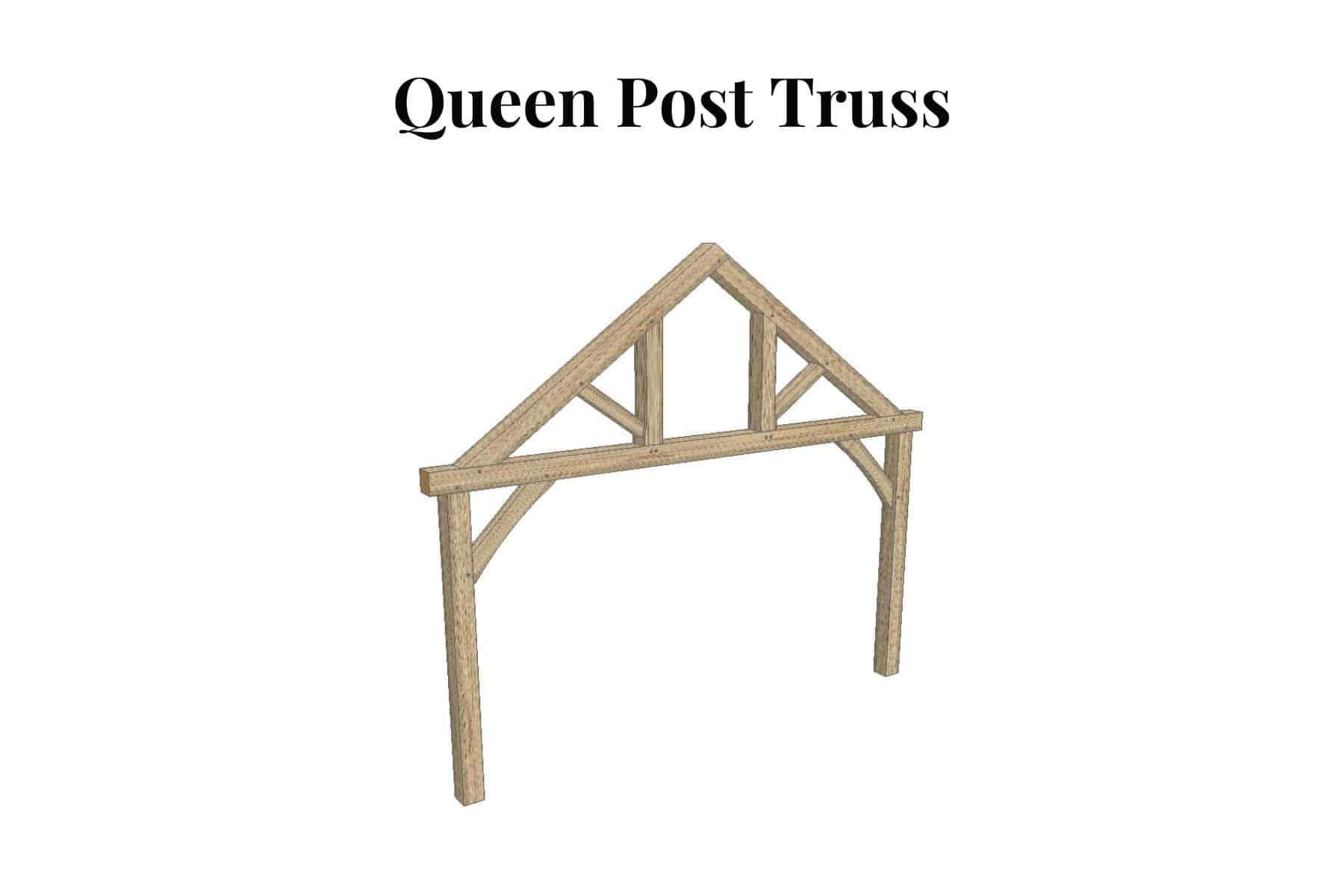
It’s slightly more versatile than the King Post, and some consider it more attractive. However, that is mostly a matter of opinion.
What are Queen Post trusses used for?
The Queen Post is a good choice for buildings slightly larger than a King Post could accommodate, such as barns and larger houses. Because of its elegant appearance, it is often chosen for venue buildings or designs where the trusses are left exposed.
Advantages
- Attractive design
- Greater span capacity than King Post trusses
- Easily modified to accommodate changes in building requirements
Disadvantages
-
- Not suitable for large or complex buildings
- More expensive than King Post trusses
- Not as strong as some truss types and may require additional support
Pratt Truss
What is a Pratt truss?
The Pratt truss is more complex than King or Queen post trusses but still has a fairly simple, straightforward design. It consists of two top chords and a bottom chord, with diagonals between them, creating a simple series of triangular shapes. Here’s what it looks like:
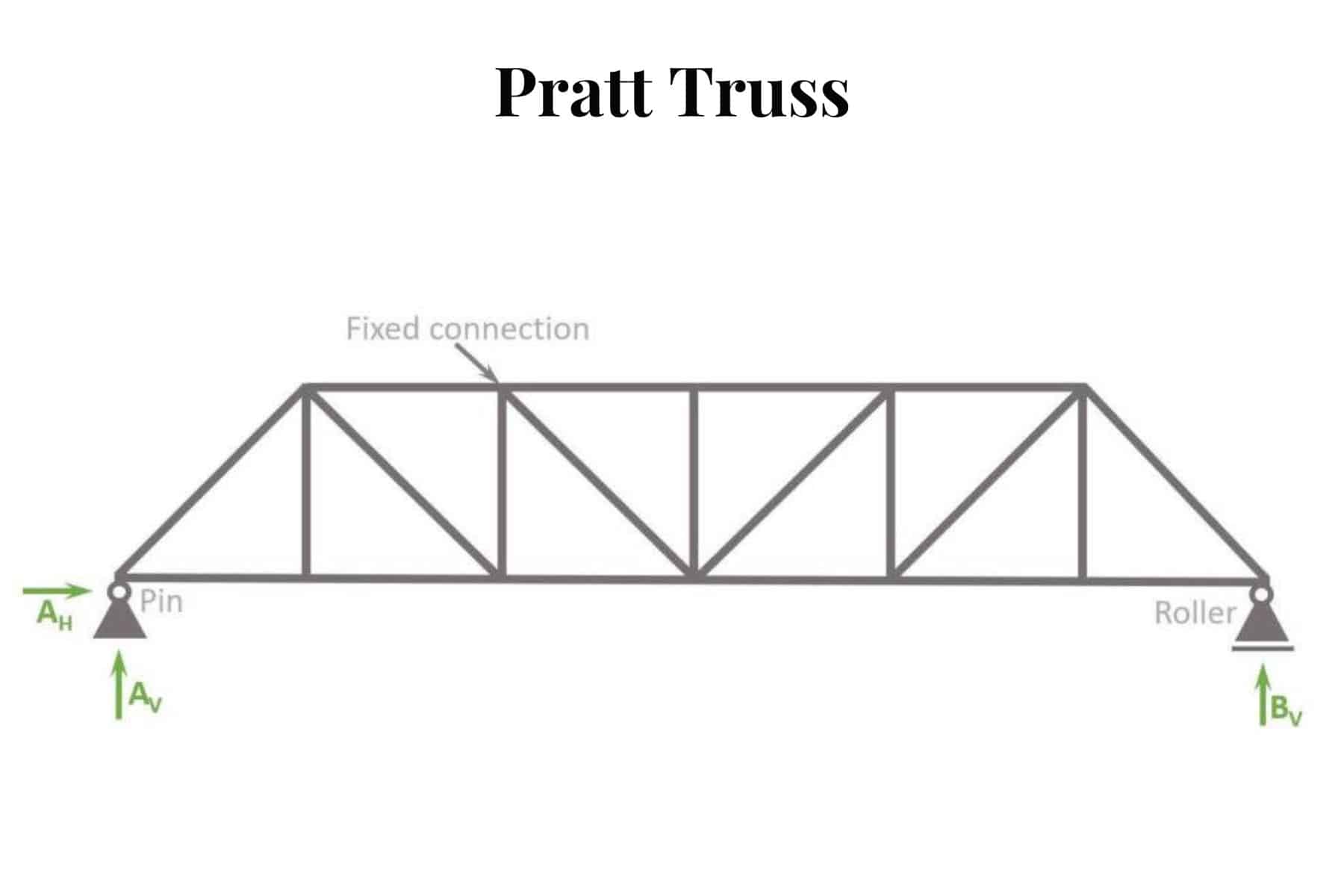
- What are Pratt trusses used for?
Pratt trusses are highly versatile and are used for a wide range of applications, including Pratt truss bridges, railways, and buildings such as ag structures and other large buildings.
Advantages
- Cost-effective since they are simple and easy to construct.
- Lightweight solution
- Very durable and sturdy
- Efficient use of materials
Disadvantages
- More susceptible to buckling under heavy loads
- May not be strong enough to support all loads
- Not suitable for really long spans
Howe Truss
What is a Howe truss?
Howe trusses are similar to Pratt trusses, except their diagonals point out from the center of the truss instead of towards the center. Like this:
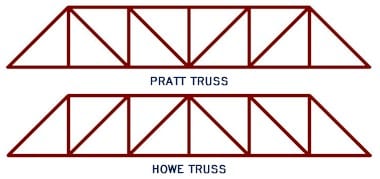
What are Howe trusses used for?
Howe trusses are well-suited for medium-sized buildings such as warehouses and factories. They can also be used for bridges, but only for relatively short spans.
Advantages
- Like the Pratt truss, the Howe truss is versatile and easy to manufacture
- Can span longer distances than Pratt trusses
- Easy to fabricate because of their simple design
Disadvantages
- Susceptible to lateral forces such as wind and seismic activity
- Still aren’t suitable for long spans
Warren Truss
What is a Warren truss?
A Warren truss is composed of a series of equilateral triangles that alternate in direction, like this:
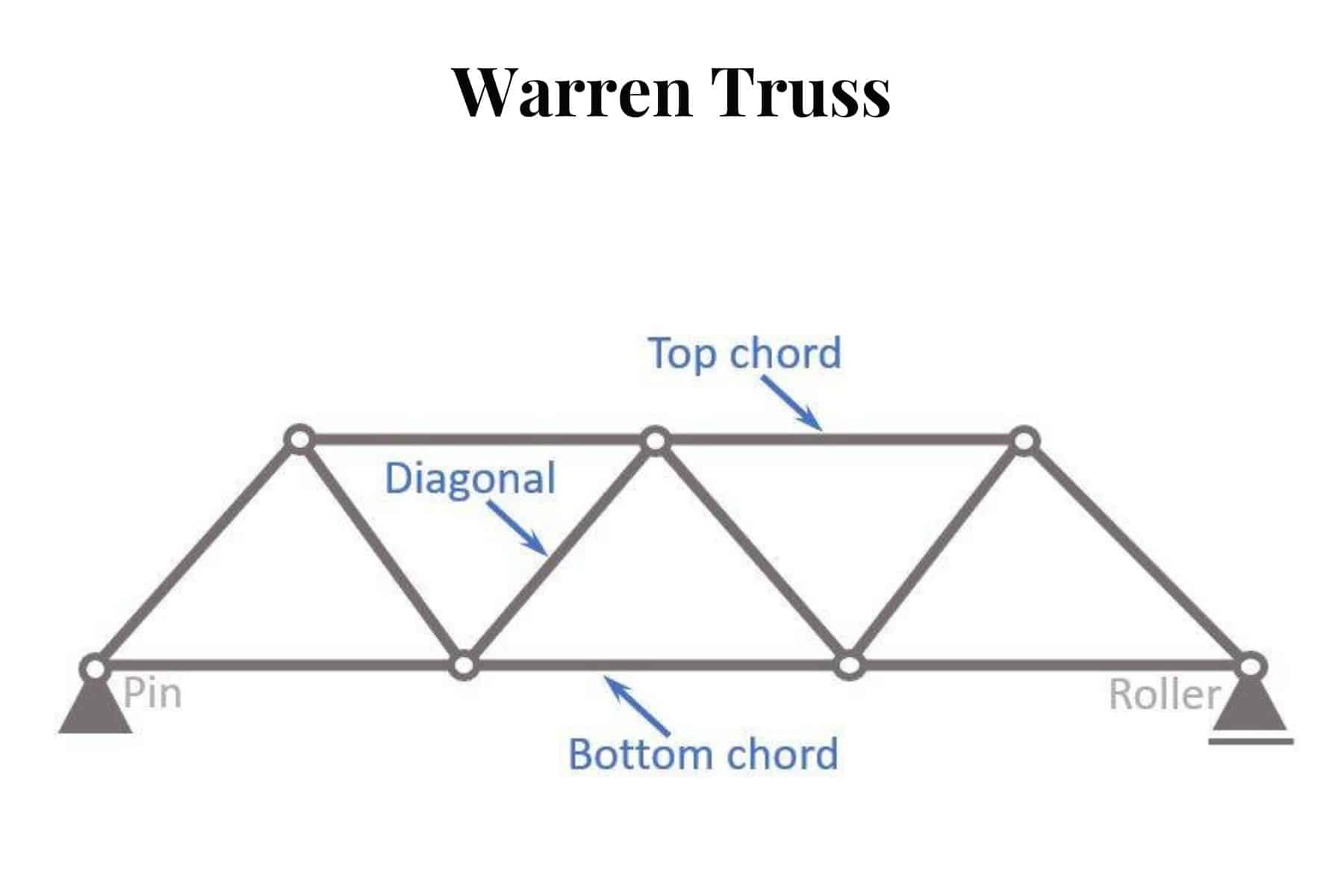
Because of their structure, Warren trusses require heavier steel as opposed to Pratt and Howe trusses. However, they are easier to construct than either Pratt or Howe trusses.
What are Warren trusses used for?
Warren trusses are ideal for structures that require long spans, such as warehouses and airplane hangers. They are also used for outdoor structures such as gazebos and pergolas.
Warren trusses perform best when the load is evenly distributed over the entire span. They are often used for projects where space is limited due to their low profile and ability to stay firm without additional support.
Advantages
- Suitable for both indoor and outdoor applications
- Can be manufactured with varying depths and heights
- Lightweight but strong
Disadvantages
-
- Not ideal for unevenly distributed loads
- Can be more challenging to design and analyze than some types
- In some cases, the diagonals in Warren trusses can interfere with the installation of services such as HVAC and electrical wiring
Fink Truss
What is a Fink truss?
Fink trusses are characterized by their W-shaped design, like this:
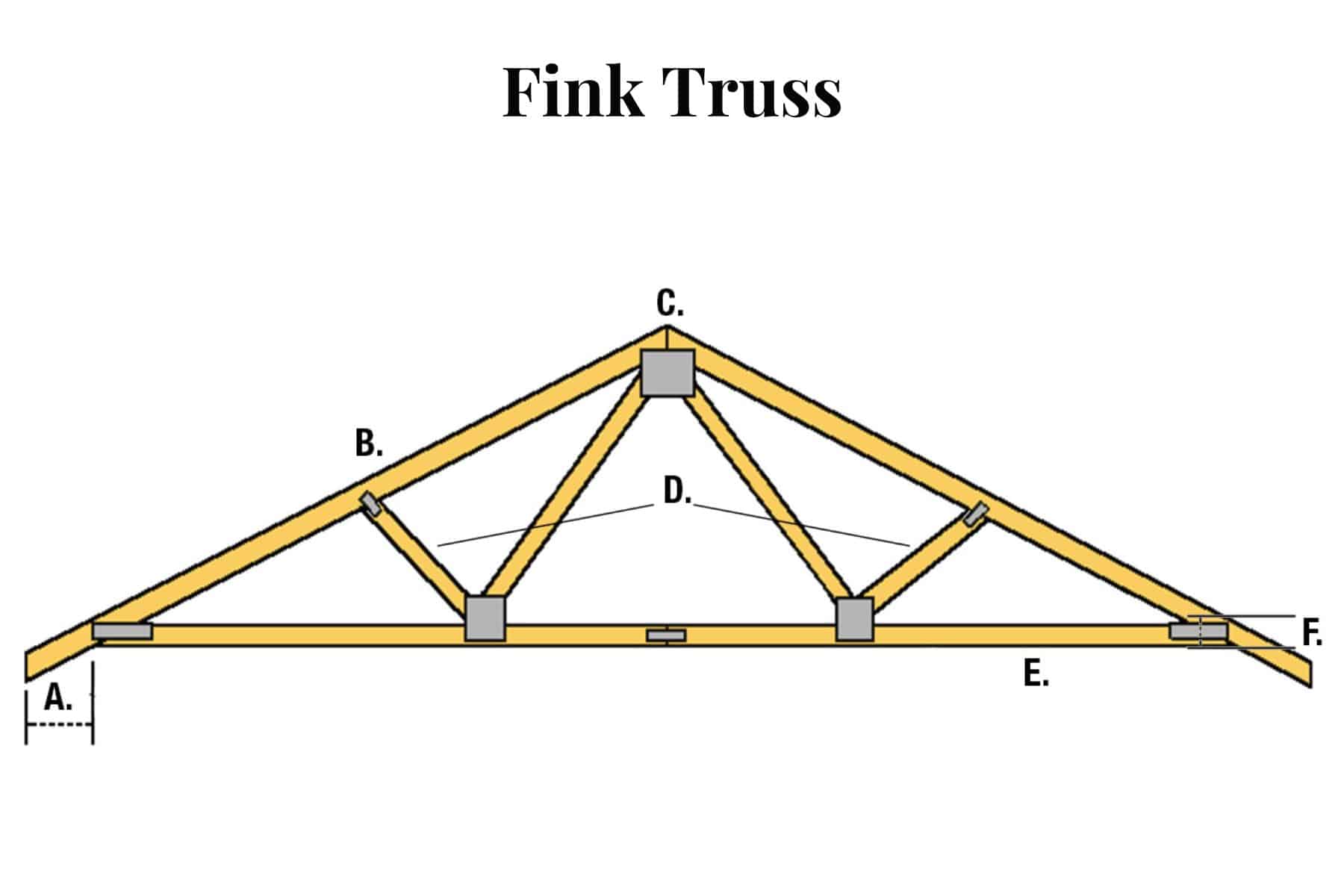
The Fink truss’s W design helps it support loads and remain sturdy.
What are Fink trusses used for?
Fink trusses can be used for various residential, commercial, and industrial applications. However, their design can cut down on headroom at the top of buildings, so they aren’t well-suited for every purpose.
Advantages
- Cost-effective
- High strength-to-weight ratio
- Versatile
Disadvantages
- Limited headroom
- Limited span lengths
- Like Warren trusses, their diagonals may interfere with the installation of other services
Flat Truss
What is a Flat truss?
A flat truss is composed of straight top and bottom chords with diagonals joining the two and forming a series of triangles:
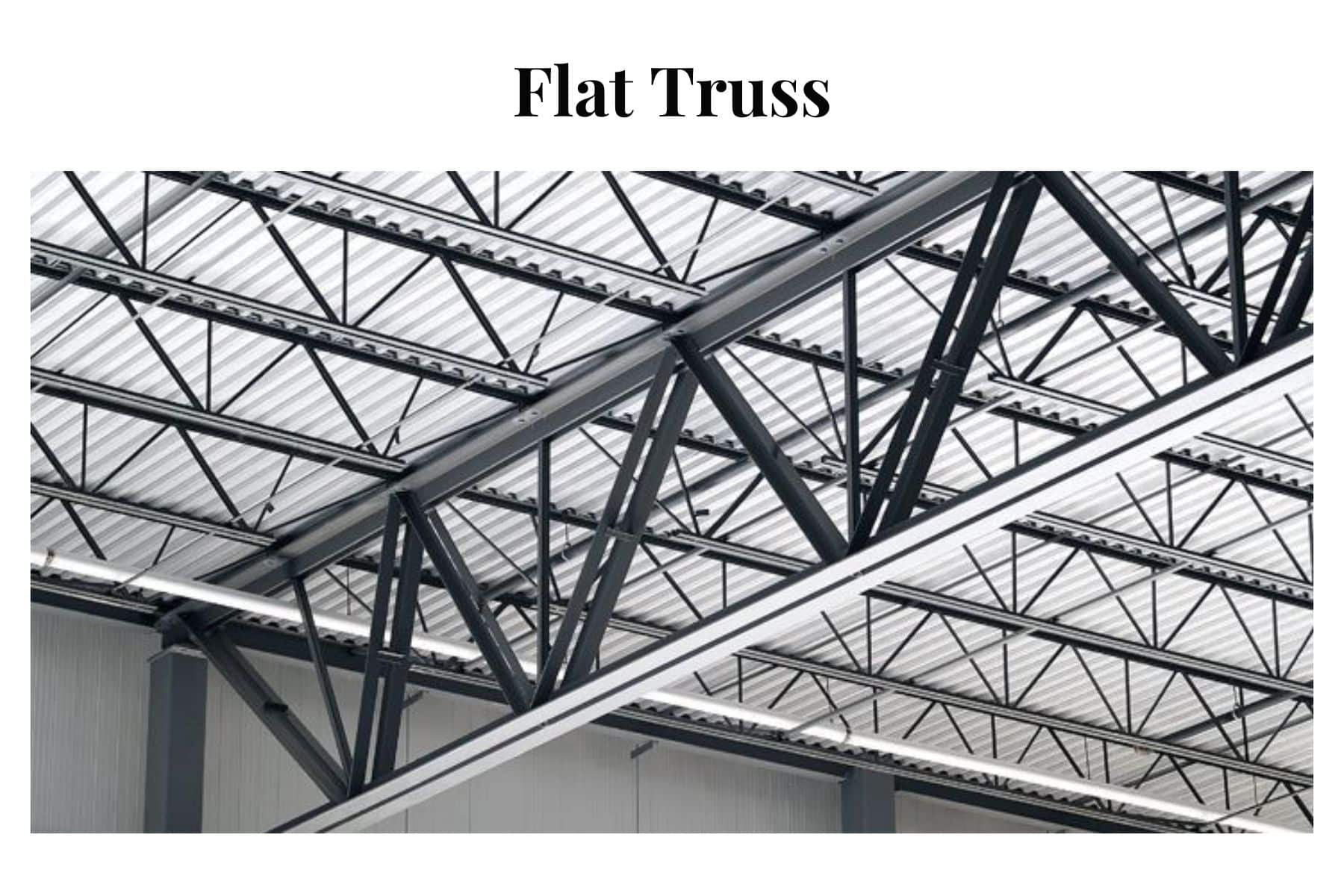
What is a Flat truss?
A flat truss is composed of straight top and bottom chords with diagonals joining the two and forming a series of triangles:
You can use them similarly to a beam, but they have greater load-bearing capacity than a simple beam.
What are Flat trusses used for?
Flat trusses eliminate the need for complex framing and are most often used for buildings such as warehouses, factories, and commercial buildings. They are suitable for any building with a flat roof.
Advantages
- Eliminate the need for complex framing
- Easy installation
- Cost-effective
- Provide a flat roof, which is ideal for buildings with rooftop HVAC systems or solar panels
Disadvantages
- Cannot span distances as long as other types
- Not suitable for buildings in areas with heavy snow
- May require additional reinforcement
Science Is Incredible!
There is an entire world of science and engineering behind every type of truss you see daily, and if you look, you’ll spot them everywhere!
These are just a few of the many, many types of trusses in the world. A few other types we didn’t mention include:
- Fan trusses
- North Light trusses
- Quadrangular trusses
- Bowstring trusses
- Scissor trusses
- Vierendeel trusses
- Gambrel trusses
And so many more!
Not to mention the construction materials that are similar to trusses, such as beams and joists—in fact, we wrote a whole article about bar joists if you're interested!
Structural engineering is a complex but fascinating world. This article is just the tip of the iceberg!
If you’re curious to know more about the design process behind our steel trusses here at Buffalo River Truss, feel free to contact us!
Conclusion
We hope you’ve enjoyed learning about the different types of trusses.
If you want to buy steel trusses for your Eastern/Southern US building, contact us today at Buffalo River Truss!
We offer quality steel trusses well suited for riding arenas, storage buildings, event venues, or ag structures.
Contact us today to learn more!
If you want to learn more about metal trusses, we have more blog post on the topic, including:
- Metal Trusses: Advantages, Disadvantages, and FAQs.
- Maximizing Space: Designing Open-Span Structures with Steel Trusses
We look forward to hearing from you.
